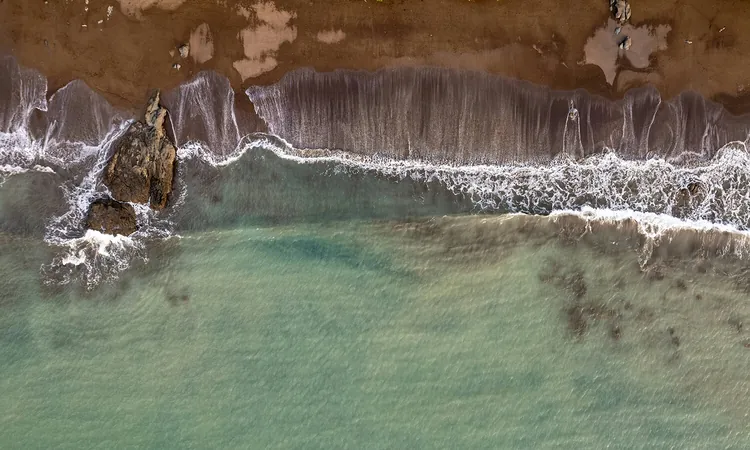
Surprising Findings on Ancient Climate Shifts: Where Did All the Sediment Go?
2024-10-12
Author: Jacques
Surprising Findings on Ancient Climate Shifts: Where Did All the Sediment Go?
Recent research challenges long-held beliefs about Earth's climatic history, specifically regarding a dramatic climate transition that occurred approximately 34 million years ago. Conventional models posited that this period of significant cooling and a drastic drop in sea levels would have led to extensive erosion and substantial sediment deposition across the ocean floor. However, a groundbreaking study from Stanford University reveals a perplexing contradiction: virtually no sediment from this time has been discovered along the continental margins of all seven continents.
This astonishing gap in the geologic record was unveiled in a study published in Earth-Science Reviews, leading researchers to ponder the crucial question: What happened to all that sediment? Senior author Stephan Graham, a professor at Stanford's Doerr School of Sustainability, emphasized the importance of answering this riddle for understanding sedimentary systems and how climate changes are captured in geological records.
The findings provide fresh insights into sediment dynamics and environmental responses during periods of extreme climatic upheaval. This research is particularly timely as it can inform our understanding of modern climate change's global impact.
From Tropical Warmth to Ice Age
During the Eocene-Oligocene transition, Earth experienced one of its most profound climate shifts, transforming from a hothouse with lush forests and high sea levels to an icehouse characterized by massive ice sheets in Antarctica and widespread ecological disruption. Prior to this, the early Eocene (from about 56 to 34 million years ago) was marked by the warmest conditions since the dinosaurs roamed the Earth.
Burton and his team originally examined early Eocene conditions, finding rich sand deposits along continental margins, which they attributed to intensified erosional processes from increasingly severe climate conditions. Intrigued by this initial discovery, they expanded their research to encompass the late Eocene and early Oligocene—when Earth's climate pivoted decisively toward cooler temperatures.
By meticulously analyzing scientific literature and geological data from offshore drilling, seismic studies, and rock outcrop investigations across over one hundred geographical sites, the researchers uncovered a striking absence of sand-rich deposition during the later period—a stark contrast to their earlier findings.
Unexpected Erosive Forces Uncovered
As they sifted through the data, the researchers were astonished to find not the expected deposits but rather numerous erosional gaps in the rock record, indicating significant sediment loss. The team speculated that powerful ocean currents, influenced by changes in water temperature and salinity, may have intensified, eroding the ocean floor and transporting sediments further away.
Moreover, the geological dynamics on continental shelves, altered by the falling sea levels, likely allowed sediments to bypass nearer sedimentary basins, depositing them instead deep on the ocean's abyssal plain. Factors like glacial erosion in Antarctica could also explain the widespread erosion patterns observed.
These findings point toward a unified model of global sedimentary dynamics during a time of massive climate change, suggesting that extreme climatic events had far-reaching effects on sediment deposition that were felt around the globe.
Implications for Understanding Modern Climate Change
While the climate change we are experiencing today is not as severe in overall magnitude compared to the shifts of the Eocene-Oligocene, the pace at which these changes are occurring is alarmingly fast. The insights gained from understanding sedimentary responses to past climate events can help us anticipate the radical alterations that may unfold on Earth's surface in response to our current trajectory of rapid climate change.
In summary, this new research not only reshapes our understanding of ancient climate dynamics but also serves as a crucial reminder of the interconnectedness of Earth’s systems. Understanding these past events may offer essential clues about the future of our planet amidst the ongoing climate crisis. As climate change continues to unfold, studying the lessons of the geological past will be vital for navigating the challenges that lie ahead.









 Brasil (PT)
Brasil (PT)
 Canada (EN)
Canada (EN)
 Chile (ES)
Chile (ES)
 España (ES)
España (ES)
 France (FR)
France (FR)
 Hong Kong (EN)
Hong Kong (EN)
 Italia (IT)
Italia (IT)
 日本 (JA)
日本 (JA)
 Magyarország (HU)
Magyarország (HU)
 Norge (NO)
Norge (NO)
 Polska (PL)
Polska (PL)
 Schweiz (DE)
Schweiz (DE)
 Singapore (EN)
Singapore (EN)
 Sverige (SV)
Sverige (SV)
 Suomi (FI)
Suomi (FI)
 Türkiye (TR)
Türkiye (TR)